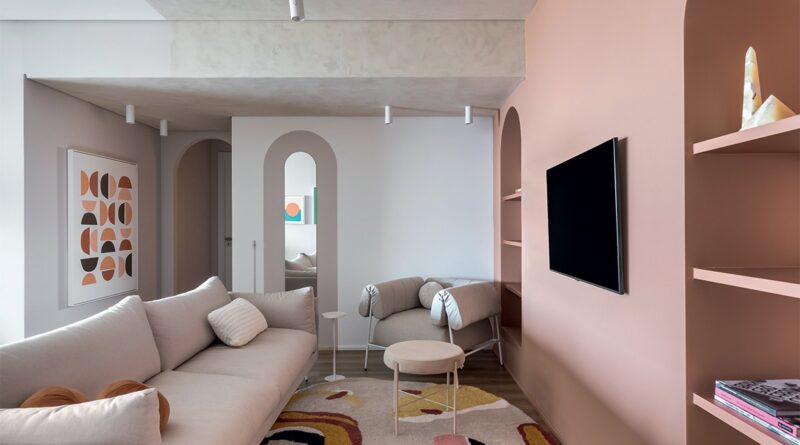Carpet the organic way: see tips on how to use it and inspiration
Rugs are a great way to make environments more welcoming and comfortable, as well as helping to define spaces. But they can also stop being simple accessories and turn into standout items.
In rooms, for example, an organically shaped rug he can be its big star decoration. As well as offering the benefits of a more conventional rug, the amorphous piece also helps break up common straight lines and brings more personality and relaxation to the project.
That’s what the designer thinks Giácomo Tomazzi, who suggests using carpets as a main piece, a design object or as an accent in a certain corner. “Organic rugs add more dynamism to the layout and make spaces more visually fluid,” she says. For him, the asymmetric shape is a good choice and the user can also compose the piece with other overlapping rugs.
Advantages of using organic carpet
For architect Juliana Garcia, the trend behind amorphous rugs is no accident. The shape of the piece, according to her, corresponds to less rigidity than anything else in the modern world, which is more fluid. “I think it’s a good idea to use them in the living room as they can give you a lot more freedom of layout,” she says.
According to her, it can be an alternative for residents who do not want a very “organized” layout around a regular or square rug, with chairs placed in front of each other.
I think the organic rug allows you to ‘play’ more with the layout and the furniture can go with it,” she says. “I also think it promotes a sense of welcome; it seems to embrace the living room or whatever space it’s in,” she adds.
How to put together carpet decor the organic way
It was this list of possibilities that guided its design apartment alcoveswith the signature of Juliana, which received this name precisely because of the demand for structures that house the decorative objects.
In the living room, an amorphous rug accompanies a double coffee table, also organically shaped. Both pieces contrast with the surrounding straight lines and square shapes, which the architect felt the need to soften. 👆
“I chose to break up some of the regularity of the square alcoves and the concrete bench below them with an organic rug that I am playing a bit with that contradiction between concrete and straight and that more amorphous style,” he says.
This is a smart way to incorporate the piece into the decor, according to her. Despite the contradiction between the different lines, harmony is created by a more pleasant language, both for those in the environment and for those looking at it.
As for the place of the carpet in the room, there are no rules. This will depend on the requirements of the resident and the sensibility of the architect. “The rule is the harmony you seek with the weights, with the open spaces, the gaps, the textures of the furniture, the fabrics…” says Juliana.
For example, he mentions the carpets that cover almost the entire room or those that delimit only a corner of the environment, next to the armchairs, as well as those that are under the coffee table, as in the case of Apartamento Nichos. “But the internal architecture is interesting because of that funny; there is no hard and fast rule,” he says.
For those who also want to venture into the place of the carpet, Giacomo gives the idea of placing them on walls. “Besides being used as a piece of art, it improves the acoustics of the room. Usually, rugs are used in living rooms or TV rooms, as they bring comfort and demarcate a certain area of the house. I also like rugs in bedrooms for an extra comfort and not to step directly on the ground,” he says.
Dimensions and thickness
According to the designer, the dimensions of the organic carpet for the living room will depend on the size of the living room, but the important thing is to “tie” all the pieces that make up the environment. “Thickness, however, depends on the type of material the rug is made of and the intent of the project. Thicker tapestries provide more comfort and thinner tapestries are more practical to clean,” he says.
Juliana, in turn, advises against using taller rugs for rooms where there is a lot of traffic because, in this way, you can lose some of the comfort of walking. “There are models with tufts of different sizes in a single piece, which makes it organic not only in shape and color, but also in texture. In one corner it is higher, in another lower. I find it very interesting, but in environments small or with a lot of passage, a very high carpet can end up making access difficult,” adds the architect.
He also says that one way to break out of the ordinary is to design the rug itself in shops that offer a bespoke service – from there, the customer can choose the shape they prefer, the dimensions that best suit the environment in question.
How to disinfect carpet
For daily carpet maintenance, Giacomo suggests using a vacuum cleaner or brushing with a little water and mild soap. But for heavier cleaning, the designer suggests hiring a specialist service.
“I think it’s worth always following the carpet manufacturer’s and suppliers’ recommendation for daily maintenance. Additionally, periodically, it’s important to wash it or hire a specialist cleaning company,” adds Juliana.
#Carpet #organic #tips #inspiration
